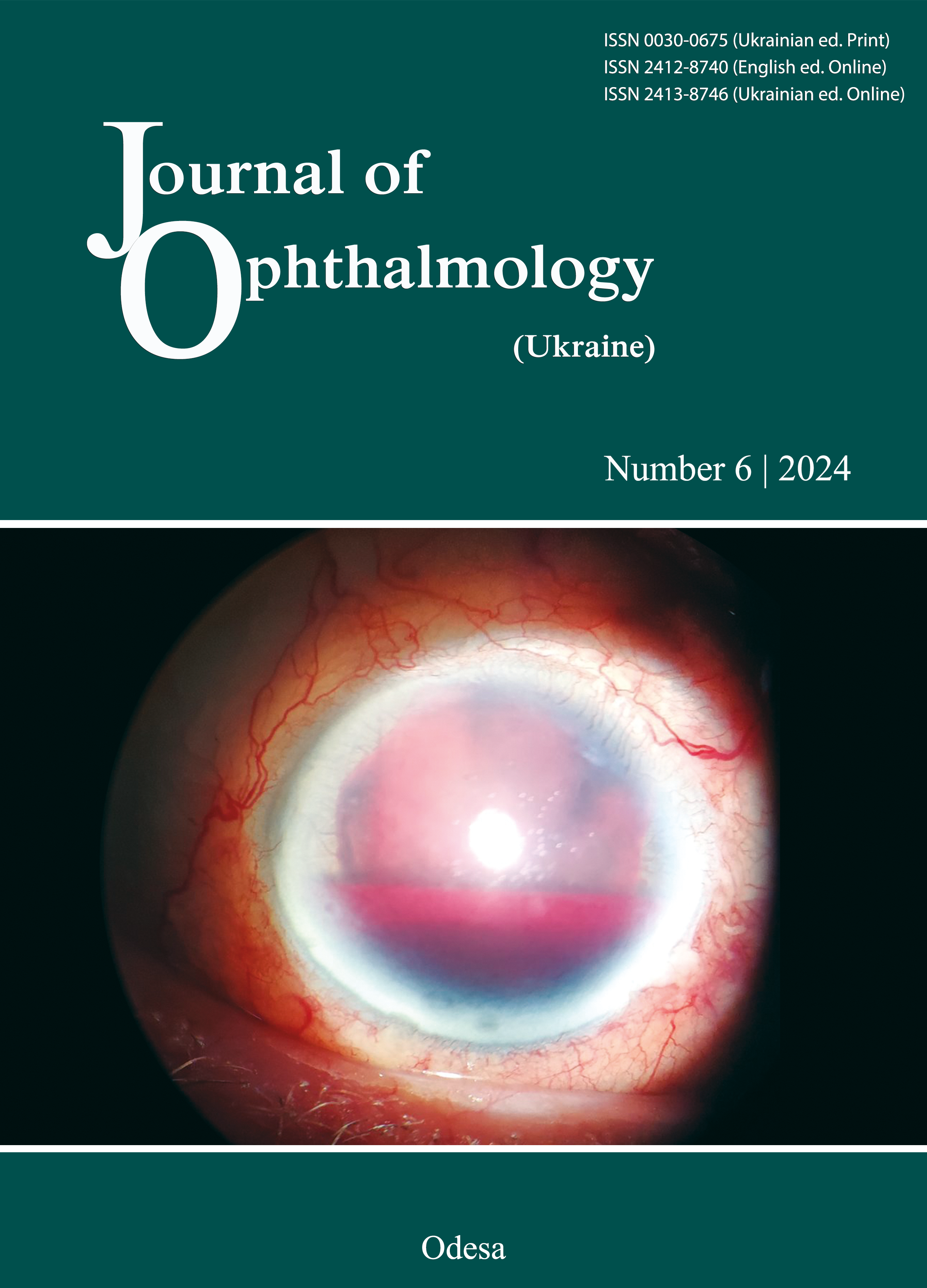Anterior segment morphometric changes and intraocular pressure lowering after phacoemulsification with intraocular lens implantation for the prevention of pseudoexfoliative glaucoma in patients with pseudoexfoliation syndrome
DOI:
https://doi.org/10.31288/oftalmolzh202461821Keywords:
cataract, intraocular pressure, neovascular glaucoma, pseudoexfoliation syndrome, phacoemulsification, glaucomaAbstract
Purpose: To assess intraocular pressure (IOP)-lowering and morphometric changes in the anterior segment after phacoemulsification with intraocular lens (IOL) implantation for the prevention of pseudoexfoliative glaucoma in eyes with pseudoexfoliation syndrome (PEX).
Material and Methods: Four hundred and eighty eight patients (625 eyes; age, 49 to 79 years) with evidence of senile cataract associated with PEX (group 1) were included in the study. The control group (group 2) included 122 patients (188 eyes) with confirmed senile cataract without PEX. All patients had phacoemulsification with IOL implantation. Goldmann applanation IOP was measured preoperatively and 1 week and 1 and 3 months postoperatively.
Results: In eyes of patients with cataract associated with PEX, the anterior chamber appeared to be 0.3 mm shallower, on average, and the anteroposterior axis of the lens, 1.02 mm longer, on average than those in eyes of patients with cataract without PEX. In addition, in eyes of the former patients, the anterior chamber showed a 30% increase in depth after cataract surgery compared to baseline. We also determined IOP values in eyes of patients with PEX and those without PEX before and after phacoemulsification with IOL implantation. Eyes of the latter patients showed a gradual 1.4-mm Hg reduction in IOP over 3 months after surgery, whereas eyes of the former patients showed an insubstantial IOP increase at 1 week, and a significant 3-mm Hg IOP lowering at 3 months after surgery.
Conclusion: In eyes with PEX, cataract was accompanied by morphometric anterior segment changes, with 0.3-mm greater anterior chamber shallowing and 1.02-mm greater elongation of the anteroposterior axis of the lens, compared to eyes without PEX. At 3 months after phacoemulsification with IOL implantation, eyes with PEX showed a percentage IOP reduction of 16.9%.
References
Grzybowski A, Kanclerz P, Ritch R. The History of Exfoliation Syndrome. Asia Pac J Ophthalmol (Phila). 2019 Jan-Feb;8(1):55-61. https://doi.org/10.22608/APO.2018226
Rumelaitiene U, Speckauskas M, Tamosiunas A. et al. Exploring association between pseudoexfoliation syndrome and ocular aging. Int Ophthalmol. 2023 Mar;43(3):847-57. https://doi.org/10.1007/s10792-022-02486-0
Tuteja S, Zeppieri M, Chawla H. Pseudoexfoliation Syndrome and Glaucoma. [Updated 2023 May 31]. In: StatPearls [Internet]. Treasure Island (FL): StatPearls Publishing; 2024 Jan. Available from: https://www.ncbi.nlm.nih.gov/books/NBK574522/
Yüksel N, Yılmaz Tuğan B. Pseudoexfoliation Glaucoma: Clinical Presentation and Therapeutic Options. Turk J Ophthalmol. 2023 Aug 19;53(4):247-56. https://doi.org/10.4274/tjo.galenos.2023.76300
Tomczyk-Socha M, Tomczak W, Winkler-Lach W, Turno-Kręcicka A. Pseudoexfoliation Syndrome - Clinical Characteristics of Most Common Cause of Secondary Glaucoma. J Clin Med. 2023 May 21;12(10):3580. https://doi.org/10.3390/jcm12103580
Mohammadi M, Johari M, Eslami Y, Moghimi S, Zarei R, Fakhraie G, et al. Evaluation of Anterior Segment Parameters in Pseudoexfoliation Disease Using Anterior Segment Optical Coherence Tomography. Am J Ophthal. 2022; 2022 Feb:234:199-204. https://doi.org/10.1016/j.ajo.2021.07.025
European Glaucoma Society Terminology and Guidelines for Glaucoma, 5th Edition. Br J Ophthalmol. 2021 Jun;105(Suppl 1):1-169. https://doi.org/10.1136/bjophthalmol-2021-egsguidelines
Wang SY, Azad AD, Lin SC, Hernandez-Boussard T, Pershing S. Intraocular Pressure Changes after Cataract Surgery in Patients with and without Glaucoma: An Informatics-Based Approach. Ophthalmol Glaucoma. 2020 Sep-Oct;3(5):343-9. https://doi.org/10.1016/j.ogla.2020.06.002
Ramezani F, Nazarian M, Rezaei L. Intraocular pressure changes after phacoemulsification in pseudoexfoliation versus healthy eyes. BMC Ophthalmol. 2021; 21(198). https://doi.org/10.1186/s12886-021-01970-y
Merkur A, Damji KF, Mintsioulis G, Hodge WG. Intraocular pressure decrease after phacoemulsification in patients with pseudoexfoliation syndrome. J Cataract Refract Surg. 2001 Apr;27(4):528-32. https://doi.org/10.1016/S0886-3350(00)00753-7
Kedwany SM, Al-Hussaini AK, Wasfi EI, El-Din MS. The Effect of Cataract Surgery on the Intraocular Pressure in Eyes with and without Pseudoexfoliation Syndrome. Ophthalmology Research: An International Journal. 2018 Jun;9(2):1-8; Article no.OR.42660. https://doi.org/10.9734/OR/2018/42660
Downloads
Published
How to Cite
Issue
Section
License
Copyright (c) 2024 Melnyk V. O., Lykhatska A. O.

This work is licensed under a Creative Commons Attribution 4.0 International License.
This work is licensed under a Creative Commons Attribution 4.0 International (CC BY 4.0) that allows users to read, download, copy, distribute, print, search, or link to the full texts of the articles, or use them for any other lawful purpose, without asking prior permission from the publisher or the author as long as they cite the source.
COPYRIGHT NOTICE
Authors who publish in this journal agree to the following terms:
- Authors hold copyright immediately after publication of their works and retain publishing rights without any restrictions.
- The copyright commencement date complies the publication date of the issue, where the article is included in.
DEPOSIT POLICY
- Authors are permitted and encouraged to post their work online (e.g., in institutional repositories or on their website) during the editorial process, as it can lead to productive exchanges, as well as earlier and greater citation of published work.
- Authors are able to enter into separate, additional contractual arrangements for the non-exclusive distribution of the journal's published version of the work with an acknowledgement of its initial publication in this journal.
- Post-print (post-refereeing manuscript version) and publisher's PDF-version self-archiving is allowed.
- Archiving the pre-print (pre-refereeing manuscript version) not allowed.












